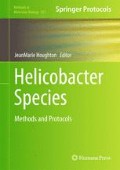Abstract
Mice used to model helicobacter gastritis should be screened by PCR prior to experimental dosing to confirm the absence of enterohepatic Helicobacter species (EHS) that colonize the cecum and colon of mice. Natural infections with EHS are common and impact of concurrent EHS infection on Helicobacter pylori-induced gastric pathology has been demonstrated.
PCR of DNA isolated from gastric tissue is the most sensitive and efficient technique to confirm the H. pylori infection status of research mice after experimental dosing. To determine the level of colonization, quantitative PCR to estimate the equivalent colony-forming units of H. pylori per μg of mouse DNA is less labor-intensive than limiting dilution culture methods. Culture recovery of H. pylori is a less sensitive technique due to its fastidious in vitro culture requirements; however, recovery of viable organisms confirms persistent colonization and allows for further molecular characterization of wild-type or mutant H. pylori strains. ELISA is useful to confirm PCR and culture results and to correlate pro- and anti-inflammatory host immune responses with lesion severity and cytokine gene or protein expression. Histologic assessment with a silver stain has a role in identifying gastric bacteria with spiral morphology consistent with H. pylori but is a relatively insensitive technique and lacks specificity. A variety of spiral bacteria colonizing the lower bowel of mice can be observed in the stomach, particularly if gastric atrophy develops, and these species are not morphologically distinct at the level of light microscopy either in the stomach or lower bowel. Other less commonly used techniques to localize H. pylori in tissues include immunohistochemistry using labeled polyclonal antisera or in situ hybridization for H. pylori rRNA. In this chapter, we will summarize strategies to allow initiation of experiments with helicobacter-free mice and then focus on PCR and ELISA techniques to verify and quantify H. pylori infection of research mice.
Access this chapter
Tax calculation will be finalised at checkout
Purchases are for personal use only
References
Lee A, Orourke J, Deungria MC, Robertson B, Daskalopoulos G, Dixon MF (1997) A standardized mouse model of Helicobacter pylori infection: introducing the Sydney strain. Gastroenterology 112:1386–1397
Lee A, Fox JG, Otto G, Murphy J (1990) A small animal model of human Helicobacter pylori active chronic gastritis. Gastroenterology 99:1315–1323
O’Rourke JL, Dixon MF, Jack A, Enno A, Lee A (2004) Gastric B-cell mucosa-associated lymphoid tissue (MALT) lymphoma in an animal model of ‘Helicobacter heilmannii’ infection. J Pathol 203:896–903
Taylor NS, Xu S, Nambiar P, Dewhirst FE, Fox JG (2007) Enterohepatic Helicobacter species are prevalent in mice from commercial and academic institutions in Asia, Europe, and North America. J Clin Microbiol 45:2166–2172
Whary MT, Fox JG (2004) Natural and experimental Helicobacter infections. Comp Med 54:128–158
Lemke LB, Ge Z, Whary MT, Feng Y, Rogers AB, Muthupalani S, Fox JG (2009) Concurrent Helicobacter bilis infection in C57BL/6 mice attenuates proinflammatory H. pylori-induced gastric pathology. Infect Immun 77:2147–2158
Stoicov C, Whary M, Rogers AB, Lee FS, Klucevsek K, Li H, Cai X, Saffari R, Ge Z, Khan IA, Combe C, Luster A, Fox JG, Houghton J (2004) Coinfection modulates inflammatory responses and clinical outcome of Helicobacter felis and Toxoplasma gondii infections. J Immunol 173:3329–3336
Fox JG, Dewhirst FE, Shen Z, Taylor NS, Paster BJ, Ericson RL, Lau CN, Correa P, Araya JC, Roa I (1998) Hepatic Helicobacter species identified in bile and gallbladder tissue from Chileans with chronic cholecystitis. Gastroenterology 114:755–763
Maurer KJ, Ihrig MM, Rogers AB, Ng V, Bouchard G, Leonard MR, Carey MC, Fox JG (2005) Identification of cholelithogenic enterohepatic helicobacter species and their role in murine cholesterol gallstone formation. Gastroenterology 128:1023–1033
Li X, Fox JG, Whary MT, Yan L, Shames B, Zhao Z (1998) SCID/NCr mice naturally infected with Helicobacter hepaticus develop progressive hepatitis, proliferative typhlitis, and colitis. Infect Immun 66:5477–5484
Fox JG, Wang TC, Rogers AB, Poutahidis T, Ge Z, Taylor N, Dangler CA, Israel DA, Krishna U, Gaus K, Peek RM Jr (2003) Host and microbial constituents influence Helicobacter pylori-induced cancer in a murine model of hypergastrinemia. Gastroenterology 124:1879–1890
Trebesius K, Panthel K, Strobel S, Vogt K, Faller G, Kirchner T, Kist M, Heesemann J, Haas R (2000) Rapid and specific detection of Helicobacter pylori macrolide resistance in gastric tissue by fluorescent in situ hybridisation. Gut 46:608–614
Whary MT, Cline JH, King AE, Hewes KM, Chojnacky D, Salvarrey A, Fox JG (2000) Monitoring sentinel mice for Helicobacter hepaticus, H. rodentium, and H. bilis infection by use of polymerase chain reaction analysis and serologic testing. Comp Med 50:436–443
Martin RM, Brady JL, Lew AM (1998) The need for IgG2c specific antiserum when isotyping antibodies from C57BL/6 and NOD mice. J Immunol Methods 212:187–192
Pronovost AD, Rose SL, Pawlak JW, Robin H, Schneider R (1994) Evaluation of a new immunodiagnostic assay for H. pylori antibody detection: correlation with histopathological and microbiological results. J Clin Microbiol 32:46–50
Bohr UR, Primus A, Zagoura A, Glasbrenner B, Wex T, Malfertheiner P (2002) A group-specific PCR assay for the detection of Helicobacteraceae in human gut. Helicobacter 7:378–383
Maurer KJ, Rogers AB, Ge Z, Wiese AJ, Carey MC, Fox JG (2006) Helicobacter pylori and cholesterol gallstone formation in C57L/J mice: a prospective study. Am J Physiol Gastrointest Liver Physiol 290:G175–G182
Fox JG (1997) The expanding genus of Helicobacter: pathogenic and zoonotic potential. Semin Gastrointest Dis 8:124–141
Boutin SR, Shen Z, Roesch PL, Stiefel SM, Sanderson AE, Multari HM, Pridhoko EA, Smith JC, Taylor NS, Lohmiller JJ, Dewhirst FE, Klein HJ, Fox JG (2010) Helicobacter pullorum outbreak in C57BL/6NTac and C3H/HeNTac barrier-maintained mice. J Clin Microbiol 48:1908–1910
Author information
Authors and Affiliations
Corresponding author
Editor information
Editors and Affiliations
Rights and permissions
Copyright information
© 2012 Springer Science+Business Media, LLC
About this protocol
Cite this protocol
Whary, M.T., Ge, Z., Fox, J.G. (2012). Verifying and Quantifying Helicobacter pylori Infection Status of Research Mice. In: Houghton, J. (eds) Helicobacter Species. Methods in Molecular Biology, vol 921. Humana Press, Totowa, NJ. https://doi.org/10.1007/978-1-62703-005-2_19
Download citation
DOI: https://doi.org/10.1007/978-1-62703-005-2_19
Published:
Publisher Name: Humana Press, Totowa, NJ
Print ISBN: 978-1-62703-004-5
Online ISBN: 978-1-62703-005-2
eBook Packages: Springer Protocols

